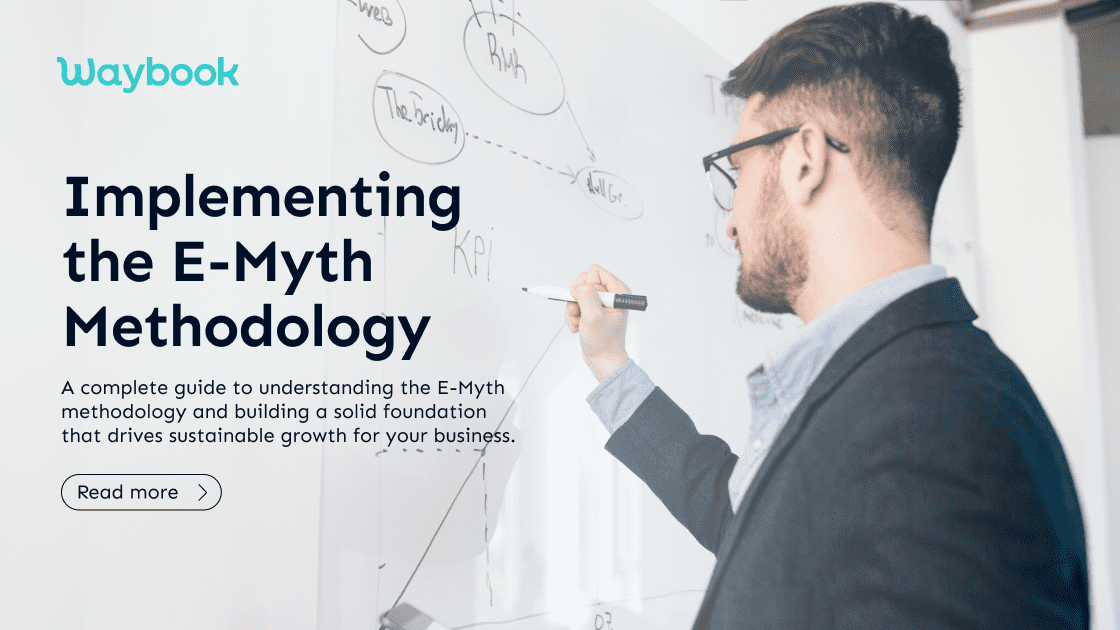In today's fiercely competitive business landscape, entrepreneurs face numerous challenges when it comes to managing and scaling their enterprises. According to a study by Small Business Trends, approximately 20% of small businesses fail within their first year, and only about 30% survive beyond the ten-year mark.
The E-myth methodology offers a comprehensive framework for systematizing your business to achieve long-term success. By emphasizing the importance of processes, standard operating procedures (SOPs), entrepreneurship, running a business, and sales, E-myth provides valuable insights into building a robust foundation that drives sustainable growth.
In this article, we will explore:
- the key factors that impact business systematizing
- the tradeoffs involved
- the challenges associated with the E-myth methodology implementation
- the significance of choosing the right software to apply E-myth principles effectively.
Understanding the E-myth Methodology
The E-myth methodology, developed by Michael E. Gerber, focuses on transforming small businesses into systems-dependent organizations. It recognizes that many entrepreneurs start their ventures with technical expertise but lack the necessary business acumen to succeed.
The E-myth approach aims to bridge this gap by emphasizing three distinct roles: the technician, the manager, and the entrepreneur. As Gerber explains, "The entrepreneurial perspective is what sets apart successful businesses. Without it, entrepreneurs risk getting lost in the daily operational details and lose sight of the big picture."
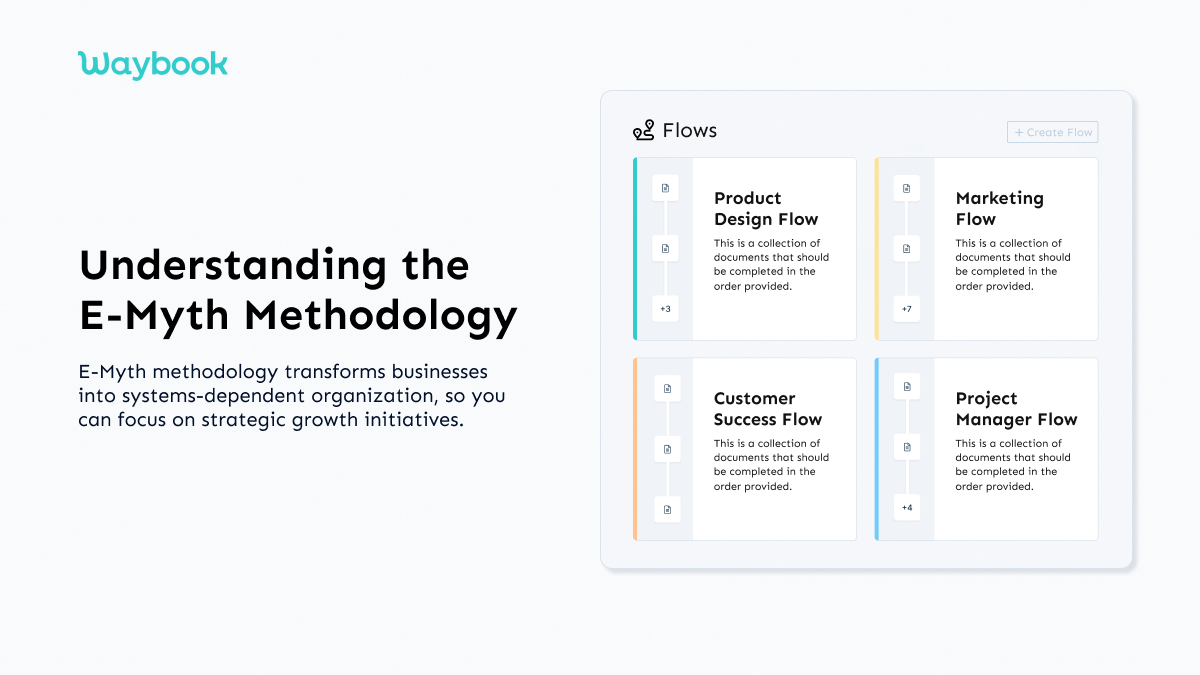
The Turnkey Revolution
The Emyth methodology has also been associated with the "turnkey revolution" in small business management. According to the National Federation of Independent Business (NFIB), businesses that embraced the turnkey approach saw an average growth rate of 15% per year, while those without a systematic model experienced only 5% growth.
The turnkey revolution enables business owners to develop comprehensive systems and processes, simplifying business operations and reducing reliance on individual expertise. By implementing turnkey solutions, entrepreneurs can effectively delegate tasks and focus on strategic growth initiatives.
The turnkey approach involves creating a business model that can be easily replicated and operated by individuals with minimal experience, as demonstrated by Subway, a renowned fast-food franchise chain that witnessed a significant expansion, increasing their number of locations by 50% within a year. It's only one of the examples of the lasting impact of Emyth methodology in transforming businesses into organized, replicable enterprises.
The Three Pillars of Small Businesses: TheEntrepreneur, The Manager, and The Technician personas
The Emyth approach revolves around three distinct personas that play critical roles in the success of a business: the Entrepreneur, the Manager, and the Technician.
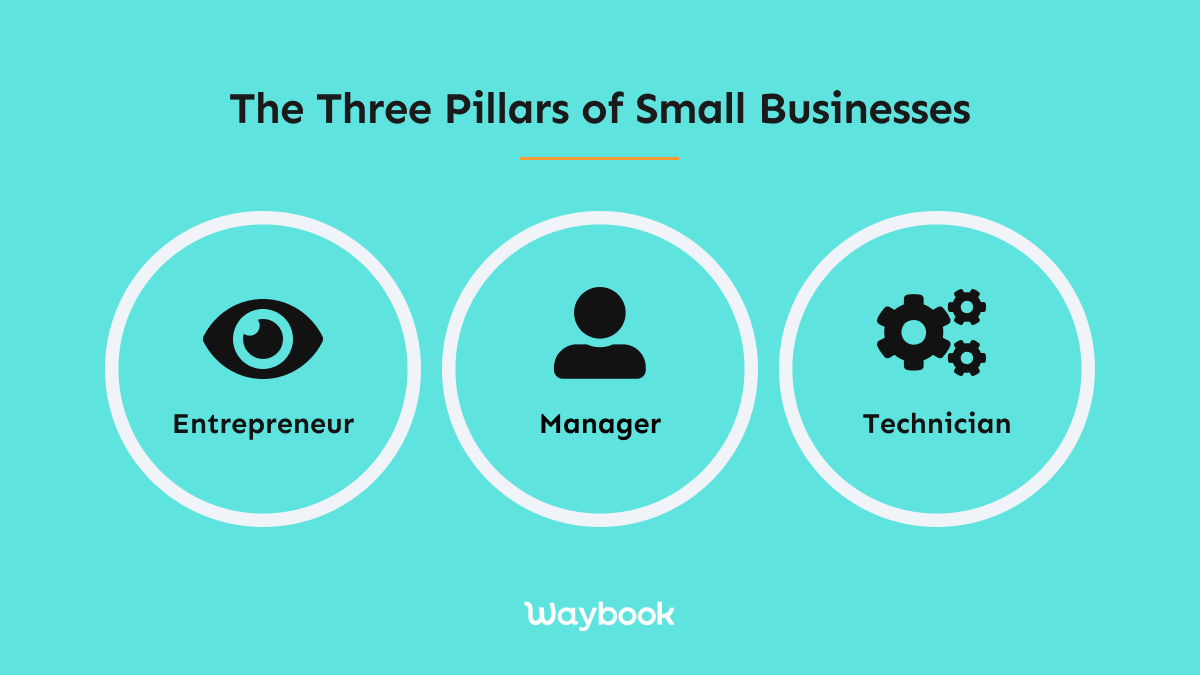
1. The Entrepreneur
The Entrepreneur is the visionary and creative force behind the business. This persona is responsible for setting the long-term vision, defining strategic goals, and identifying opportunities for growth. Entrepreneurs are driven by innovation, and they constantly seek new ways to improve and expand their business. They are future-oriented and are not afraid to take calculated risks to achieve their objectives. The Entrepreneur in the Emyth approach is the one who creates the roadmap for the business's success and ensures that the company is continually evolving and staying ahead in the market.
2. The Manager
The Manager is the persona that focuses on organizing and executing the plans set by the Entrepreneur. This individual is responsible for implementing systems and processes to ensure the smooth day-to-day operation of the business. Managers are detail-oriented, highly organized, and proficient in resource allocation. They excel at managing people, projects, and timelines. In the Emyth approach, the Manager plays a crucial role in systematizing the business, defining Standard Operating Procedures (SOPs), and establishing efficient workflows. They work to maintain the structure and stability needed to execute the Entrepreneur's vision effectively.
3. The Technician
The Technician is the skilled expert who possesses the technical knowledge and hands-on skills required to deliver the products or services offered by the business. Technicians are highly competent and take pride in their craft. They are often drawn to entrepreneurship because of their expertise and passion for their work. In the Emyth approach, the Technician is responsible for delivering the core value of the business to customers. However, a common pitfall is that Technicians can become so immersed in their technical work that they neglect crucial aspects of business management and growth.
In many small businesses, especially those started by technicians turned entrepreneurs, the Technician often dominates the other two personas. The Emyth approach emphasizes the need for a balance between these three personas. Successful business owners must learn to embody all three roles effectively. The Entrepreneur provides the vision and direction, the Manager ensures efficient operations, and the Technician delivers the high-quality products or services.
By understanding and embracing these three personas, business owners can strategically allocate their time and energy to work "on" the business rather than just "in" the business. This approach allows entrepreneurs to build scalable, systematized enterprises that can thrive even in their absence, enabling them to focus on strategic growth and long-term success.
Systematizing Processes and SOPs
One of the fundamental pillars of the E-myth methodology is the systematization of processes and the development of standard operating procedures (SOPs). According to a study by McKinsey, companies with well-documented processes and SOPs are 30% more likely to be high performers in their industry.
Efficient processes ensure consistency, minimize errors, and enable scalability. For example, Skoda Auto, in Czech Republic, streamlined its assembly line processes and implemented detailed SOPs, resulting in a 20% increase in production efficiency. By documenting procedures in SOPs, businesses can maintain quality standards, improve training programs, and streamline operations. Effective SOPs provide step-by-step instructions, clarify roles and responsibilities, and enhance overall productivity.
The Role of Entrepreneurship and Business Vision
E-myth highlights the importance of the entrepreneur's role in shaping the long-term vision and direction of the business. According to Forbes, 70% of entrepreneurs believe that having a clear vision is crucial for success. Entrepreneurs are responsible for creating a compelling vision, setting strategic goals, and identifying opportunities for growth.
They bring innovation, creativity, and a forward-thinking mindset to drive the business forward. Balancing the demands of day-to-day operations with the visionary aspects of entrepreneurship is crucial for sustainable success.
"Innovation distinguishes between a leader and a follower.", Steve Jobs
Running a Business with a Systematic Approach
To implement the E-myth methodology successfully, business owners must adopt a systematic approach to managing their enterprises. This involves creating clear organizational structures, defining roles and responsibilities, and establishing efficient communication channels.
A study published in the Harvard Business Review found that companies that implement effective management systems experience a 20% increase in employee productivity.
By developing effective management systems, businesses can delegate tasks, empower employees, and foster a culture of accountability and continuous improvement.
"Good business leaders create a vision, articulate the vision, passionately own the vision, and relentlessly drive it to completion.", Jack Welch, Former CEO at GE
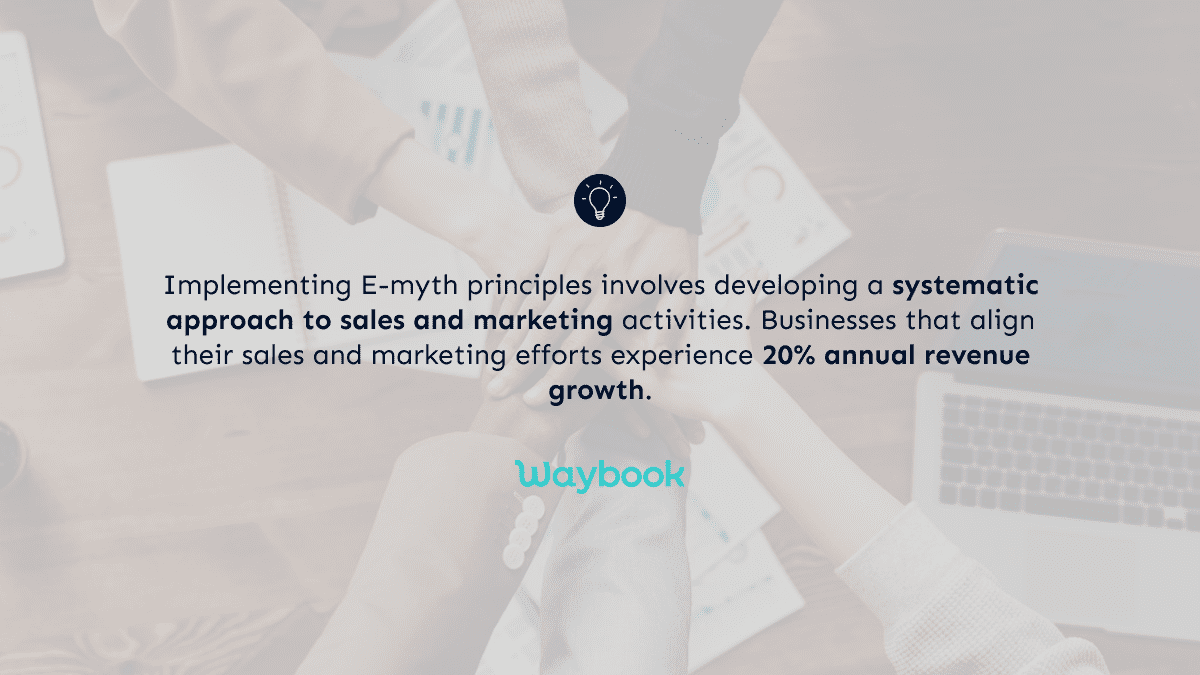
Sales and Marketing in a Systematized Business
Sales and marketing play a vital role in driving revenue and growth. Implementing E-myth principles involves developing a systematic approach to sales and marketing activities.
HubSpot reveals that businesses that align their sales and marketing efforts experience 20% annual revenue growth. This includes defining target markets, creating marketing strategies, and implementing sales processes that ensure consistency and effectiveness.
By systematizing sales and marketing, businesses can track and measure performance, identify areas for improvement, and achieve sustainable sales growth. As Brian Tracy, renowned sales expert, advises, "Sales success comes after you stretch yourself past your limits on a daily basis."
Balancing Factors and Tradeoffs
Implementing the E-myth methodology requires balancing various factors. For instance, while systematizing processes is crucial, it is also essential to allow room for flexibility and adaptability. Finding the right balance between standardization and customization can be challenging. Businesses must tailor the methodology to their unique needs and industry requirements.
"Balance is not something you find, it's something you create.", former CEO of Starbucks.
Challenges in Implementing E-myth Methodology
Implementing the E-myth methodology is not without its challenges. Resistance to change, lack of employee buy-in, and the need for additional training can hinder the adoption of new systems and processes. A study by Deloitte found that 65% of companies struggle with resistance to change during business transformations.
Moreover, finding the right balance between standardization and customization can be complex, as businesses must tailor the methodology to their unique needs and industry requirements. As Peter Drucker, management consultant, famously said, "Culture eats strategy for breakfast."
Importance of Choosing the Right Software
Selecting the appropriate software is a critical consideration when applying E-myth lessons to your business. The right software can streamline operations, enhance productivity, and provide valuable insights through data analysis.
According to a survey by Capterra, 78% of small businesses believe that technology positively impacts their productivity.
It is essential to choose software that aligns with your business needs, integrates well with existing systems, and offers scalability as your business grows. Robust software solutions can automate repetitive tasks, facilitate collaboration, and improve overall efficiency.
"The first rule of any technology used in a business is that automation applied to an efficient operation will magnify the efficiency. The second is that automation applied to an inefficient operation will magnify the inefficiency.", Bill Gates, co-founder of Microsoft
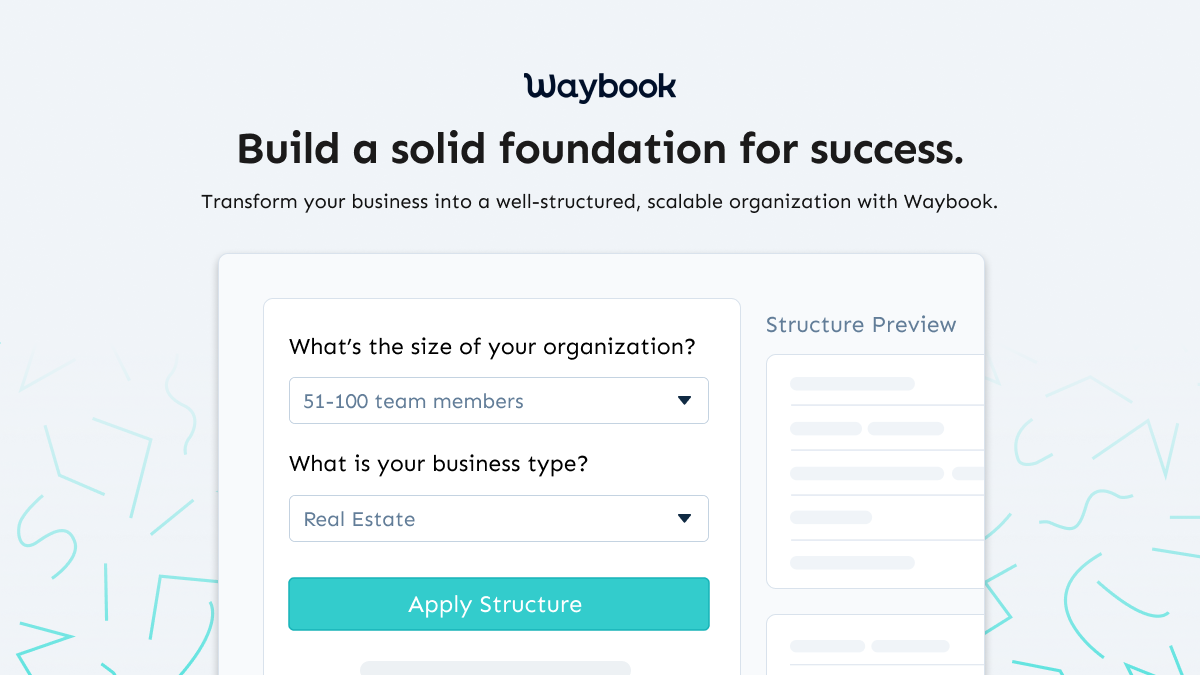
Here at Waybook, we've been helping companies not only on E-myth methodology, as well as businesses on Entrepreneurial Operating System® (EOS®) and other scalable growth systems.
Whether you're a solopreneur in need to get your business out of your head or a Fortune 500 corporation, we've got the right expert to help you on creating a source of truth to your company or migrating your existing one. If you want to learn more, you can start exploring Waybook today for free or immediately get on a call with one of our Consultants.
In a nutshell
Implementing the E-myth methodology can transform your business into a well-structured, scalable organization. By focusing on processes, SOPs, entrepreneurship, running a business, and sales, you can build a solid foundation for success.
However, it is crucial to find the right balance, address challenges, and choose the appropriate software to support your Emyth implementation. By embracing the systematic approach advocated by E-myth, you can pave the way for sustainable growth and achieve your entrepreneurial aspirations.
Want to get more insights on the future of Remote Growth & Leadership? Check out our related resources:
- The 10 Best Prompts to Leverage AI-|Powered Playbooks and SOPs [Real Examples]
- What is the Entrepreneurial Operating System® (EOS®) and How To Unleash Business Growth With It
- Automating employee training and onboarding with AI

